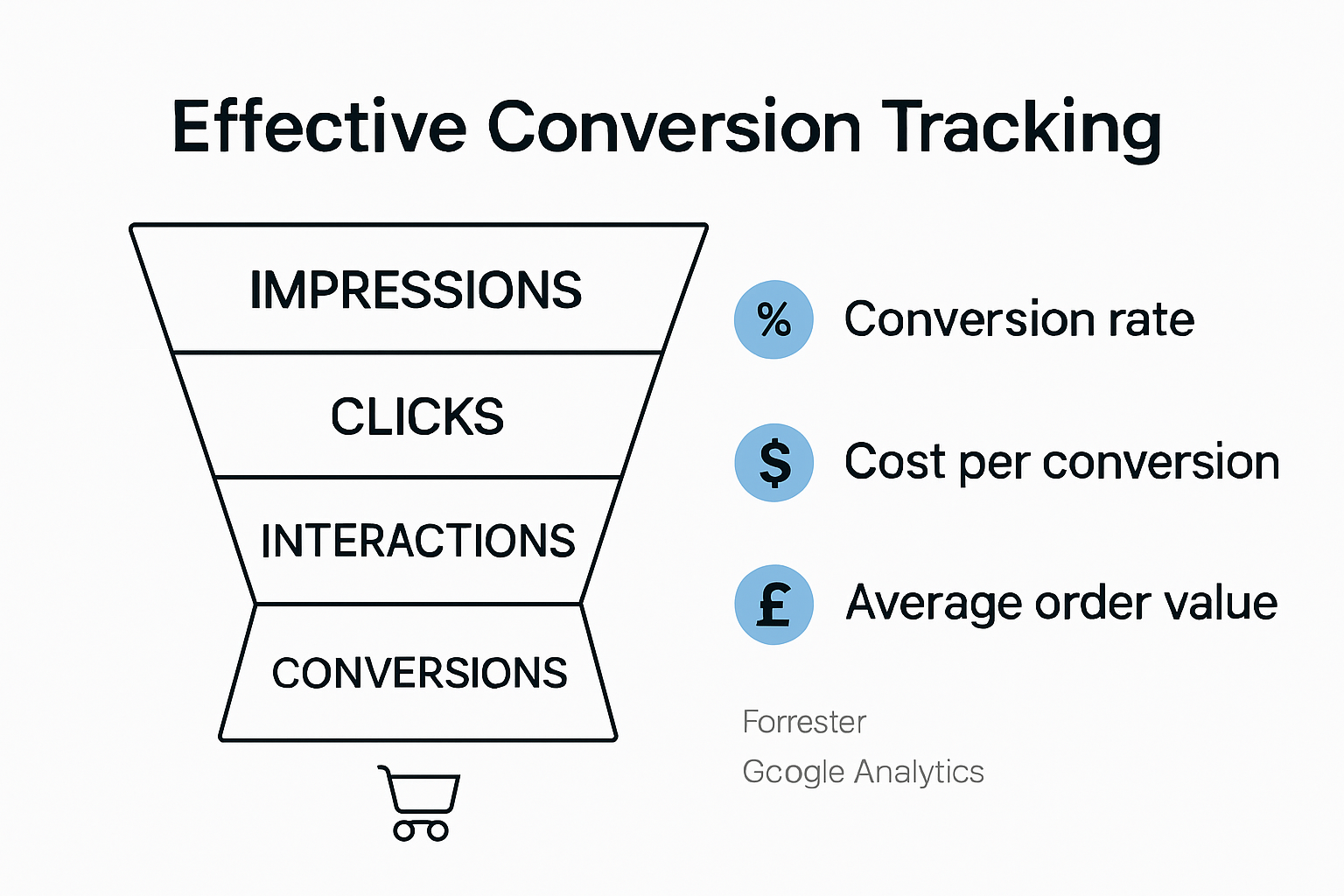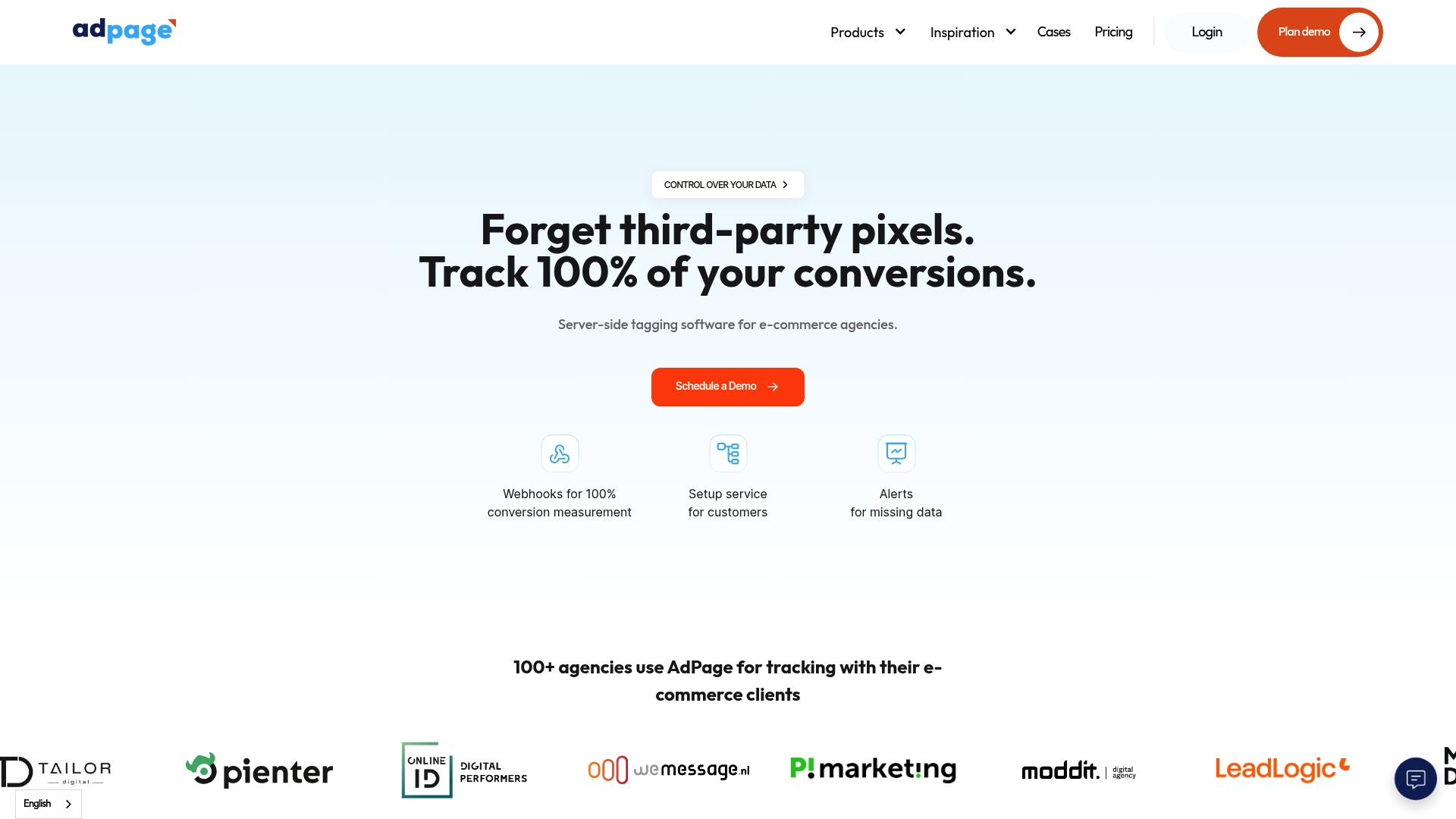Tracking conversions sounds simple until you realize just how much is at stake. Businesses that harness sophisticated conversion monitoring can increase their marketing efficiency by up to 20 percent, which is a huge leap for something that often gets overlooked. The real surprise? Most of the gains are not from flashy campaigns but from quietly fixing unnoticed gaps in the user journey.
Table of Contents
- Understanding Conversion Monitoring Essentials
- Key Metrics for Effective Conversion Tracking
- Best Tools and Techniques for Accurate Data
- Advanced Tips to Optimise Conversion Rates
Quick Summary
| Takeaway | Explanation |
|---|---|
| Define clear conversion goals | Establish specific actions to measure the success of your digital strategies, such as purchases or sign-ups. |
| Utilize server-side tracking | Employing server-side tracking ensures more reliable data collection and mitigates issues like ad-blocker interference. |
| Segment and contextualize your metrics | Break down performance data by demographics and time to gain deeper insights into user behavior and marketing effectiveness. |
| Implement A/B testing strategically | Use well-defined hypotheses and test variations comprehensively to make informed decisions about website changes. |
| Focus on user experience and technical performance | Improving speed and navigation enhances user engagement, which is directly linked to better conversion rates. |
Understanding Conversion Monitoring Essentials
Conversion monitoring represents a critical process for businesses seeking to understand and optimize their digital performance. At its core, this analytical approach tracks how potential customers transform from casual visitors into active purchasers, providing invaluable insights into marketing effectiveness and user behaviour.
The Fundamental Mechanics of Conversion Tracking
Converting website traffic into meaningful actions requires a strategic and systematic approach. Learn how to track conversions comprehensively by understanding the key elements that define successful monitoring. Conversion tracking goes beyond simple click measurements, encompassing a holistic view of user interactions across multiple digital touchpoints.
According to Google Analytics, effective conversion monitoring involves identifying specific actions that represent value for your business. These actions might include product purchases, newsletter sign-ups, downloaded resources, or completed contact forms. By establishing clear conversion goals, businesses can quantify the real impact of their digital strategies.
Mapping the User Journey Through Conversion Data
Understanding conversion monitoring requires a nuanced approach to data interpretation. Modern analytics platforms enable businesses to track user interactions from initial website entry through to final purchase, revealing critical insights about potential friction points in the customer journey.
Research from McKinsey & Company highlights that businesses with sophisticated conversion monitoring can improve their marketing efficiency by up to 20%. This involves not just tracking conversions but understanding the contextual factors that influence user decision-making.
Technical Foundations of Robust Conversion Monitoring.
Successful conversion monitoring relies on sophisticated technical infrastructure. Server-side tracking methods have emerged as a superior alternative to traditional client-side techniques, offering more reliable and comprehensive data collection. These advanced approaches help mitigate challenges like ad-blocker interference and provide a more accurate representation of user interactions.
Implementing robust conversion monitoring requires careful consideration of technical details, including:
- Data Integrity: Ensuring accurate and consistent tracking across different platforms and devices
- Privacy Compliance: Maintaining user consent and adhering to data protection regulations
- Real-time Analytics: Capturing conversion events as they occur, enabling immediate insights and potential interventions
By embracing a comprehensive approach to conversion monitoring, businesses can transform raw data into strategic insights, driving more informed marketing decisions and improving overall digital performance.
Key Metrics for Effective Conversion Tracking
Tracking conversions requires a strategic approach to measuring performance through carefully selected metrics that provide meaningful insights into user behavior and marketing effectiveness. Uncover advanced analytics strategies to transform raw data into actionable intelligence.
Fundamental Conversion Performance Indicators
Identifying the right metrics is crucial for understanding digital marketing success. According to Google Marketing Platform, key performance indicators provide a comprehensive view of conversion dynamics. Critical metrics include:
- Conversion Rate: The percentage of visitors completing a desired action
- Cost per Conversion: Total marketing expenditure divided by successful conversions
- Average Order Value: Total revenue generated per transaction
Research from Forrester Research indicates that businesses tracking these metrics can improve marketing efficiency by up to 35% through data-driven decision-making.
Advanced User Engagement Metrics
Beyond basic conversion measurements, sophisticated tracking involves deeper user engagement analysis. Metrics such as bounce rate, time on site, and user journey mapping reveal nuanced insights into customer interactions. These advanced indicators help businesses understand potential barriers in the conversion funnel.
Analytical frameworks demonstrate that comprehensive metric tracking goes far beyond simple numerical data. For instance, understanding micro-conversions like email sign-ups or product page views can provide early indicators of potential full conversions.
Contextual Performance Analysis
Effective conversion tracking requires contextualizing metrics within broader business objectives. Different industries and business models demand unique approaches to measuring conversion success. E-commerce platforms might prioritize purchase completion rates, while service-based businesses could focus on lead generation and consultation requests.
Key considerations for robust metric analysis include:
- Segmentation: Breaking down metrics by user demographics, traffic sources, and device types
- Temporal Analysis: Tracking performance variations across different time periods
- Comparative Benchmarking: Understanding performance relative to industry standards
By adopting a holistic approach to conversion metrics, businesses can develop more sophisticated marketing strategies that adapt to changing user behaviors and market dynamics. The goal is not just collecting data, but transforming that data into meaningful strategic insights that drive continuous improvement.
Successful conversion tracking is an iterative process. Regularly reviewing and refining metric selection ensures that businesses remain agile and responsive to emerging trends and customer preferences.

Best Tools and Techniques for Accurate Data
Accurate data collection represents the foundation of effective conversion monitoring, requiring sophisticated tools and strategic techniques that enable businesses to capture comprehensive user insights. Explore advanced tracking optimization strategies to transform your digital performance measurement.
Server-Side Tracking Technologies
Modern conversion monitoring demands advanced tracking methodologies that transcend traditional client-side approaches. Server-side tracking offers superior data reliability by processing user interactions directly through backend systems, mitigating challenges like ad-blocker interference and browser tracking limitations.
To clarify the distinction and advantages of server-side versus client-side tracking technologies mentioned in this section, here's a comparison table.
| Tracking Method | Key Advantages | Key Limitations |
|---|---|---|
| Server-Side Tracking | More reliable data collection; mitigates ad-blockers; collects precise user interactions across platforms | Requires technical integration; can be complex to maintain |
| Client-Side Tracking | Easier to implement; relies on browser-based methods | Vulnerable to ad-blockers; can miss data due to browser limitations |
According to Mozilla Developer Network, server-side tracking provides more robust data collection mechanisms, enabling businesses to capture precise user interactions without relying solely on browser-based technologies. This approach ensures more comprehensive and accurate conversion data across multiple digital platforms.
Advanced Analytics Platform Integration
Selecting the right analytics platforms is crucial for maintaining data accuracy and deriving meaningful insights. Contemporary businesses require integrated solutions that offer real-time tracking, comprehensive reporting, and seamless cross-platform compatibility.
Research from Gartner emphasizes the importance of choosing analytics tools that provide:
- Comprehensive Data Aggregation: Combining multiple data sources for holistic insights
- Advanced Segmentation: Breaking down user interactions by critical demographic factors
- Predictive Analytics: Utilizing machine learning to forecast potential conversion trends
Data Integrity and Privacy Compliance
Ensuring data accuracy goes beyond technical implementation, requiring rigorous approaches to maintaining privacy and regulatory compliance. Modern conversion tracking must balance comprehensive data collection with stringent user consent management.
Key strategies for maintaining data integrity include:
To help you evaluate and implement robust conversion monitoring, the following table summarizes key strategies for ensuring data integrity and privacy compliance highlighted in the section.
| Strategy | Description |
|---|---|
| Consent Management | Implement transparent user permission frameworks |
| Data Anonymization | Protect individual user identities while retaining essential metrics |
| Regular Auditing | Continuously verify tracking mechanisms for accuracy and compliance |
- Consent Management: Implementing transparent user permission frameworks
- Data Anonymization: Protecting individual user identities while capturing essential interaction metrics
- Regular Auditing: Continuously verifying tracking mechanisms for accuracy and compliance
The National Forum on Education Statistics recommends establishing realistic conversion processes that involve systematic data verification, backup protocols, and careful synchronization between tracking systems.
Successful conversion monitoring requires a holistic approach that combines cutting-edge technologies, strategic implementation, and a commitment to data accuracy. By embracing sophisticated tracking techniques and maintaining rigorous standards, businesses can transform raw data into actionable strategic insights that drive continuous improvement and informed decision-making.
Advanced Tips to Optimise Conversion Rates
Improving conversion rates requires a sophisticated, data-driven approach that goes beyond basic marketing strategies. Discover expert conversion enhancement techniques to transform your digital performance and drive meaningful business growth.
Strategic A/B Testing Methodologies
A/B testing represents a cornerstone of advanced conversion optimization, enabling businesses to make precise, evidence-based improvements to their digital platforms. According to Nielsen Norman Group, effective A/B testing involves creating carefully constructed hypotheses and systematically evaluating user interactions.
Research from Optimizely reveals that successful A/B testing goes beyond simple design variations. Key strategies include:
- Precise Hypothesis Formulation: Developing clear, measurable expectations for potential changes
- Comprehensive User Segmentation: Testing variations across different user demographics
- Statistical Significance: Ensuring results are mathematically robust and meaningful
Psychological Conversion Optimization Techniques
Understanding user psychology plays a crucial role in improving conversion rates. Behavioural economics and cognitive psychology provide insights into how users make decisions and interact with digital platforms.
Advanced conversion optimization involves:
- Social Proof Mechanisms: Leveraging user testimonials and real-time interaction data
- Cognitive Ease: Simplifying user interfaces to reduce decision-making friction
- Emotional Triggering: Creating compelling narratives that resonate with user motivations
Technical Performance and User Experience Enhancement
Conversion rates are deeply interconnected with technical performance and overall user experience. Microsecond differences in page load times can dramatically impact user engagement and conversion potential.
Key technical optimization strategies include:
- Page Speed Optimization: Reducing load times and improving server response
- Mobile Responsiveness: Ensuring seamless experiences across all device types
- Intuitive Navigation: Designing clear, frictionless user journeys
By implementing a holistic approach that combines data analysis, psychological insights, and technical excellence, businesses can create powerful conversion optimization strategies. The goal is not just to increase numbers, but to create genuinely valuable user experiences that naturally drive conversions and business growth.

Successful conversion rate optimization is an ongoing process of continuous learning, testing, and refinement. Businesses must remain agile, embracing new technologies and user behavior insights to stay ahead in an increasingly competitive digital landscape.
Frequently Asked Questions
What is conversion monitoring and why is it important?
Conversion monitoring is the process of tracking user actions that indicate successful interactions, such as purchases or sign-ups. It is important because it helps businesses understand the effectiveness of their marketing strategies and optimize the user journey, ultimately leading to higher conversion rates.
How can I effectively track conversions on my website?
To effectively track conversions, define clear conversion goals, use server-side tracking for more reliable data, segment your audience for deeper insights, and regularly review performance metrics for adjustments to your strategies.
What are the key metrics to monitor for conversions?
Key metrics to monitor include conversion rate, cost per conversion, and average order value. Advanced user engagement metrics, such as bounce rate and time on site, also provide valuable insights into how users interact with your site.
How does A/B testing contribute to improving conversion rates?
A/B testing allows businesses to experiment with different website elements and design variations to see which performs better. By developing precise hypotheses and testing comprehensively across user segments, it provides evidence-based insights for optimization.
Take Control of Your Conversion Tracking Today
Are you facing challenges with incomplete or unreliable conversion analytics as discussed in our guide on effective monitoring? Many marketers and agencies miss out on vital data when relying purely on traditional tracking tools. If you worry about data gaps from ad blockers or compliance headaches, it is time to act. The article highlights how advanced tracking methods and accurate data are essential for boosting results and avoiding missed opportunities.

Experience the difference with AdPage's server-side tagging. Witness 100 percent conversion monitoring, seamless GDPR compliance and powerful consent management, all designed to transform how you capture and analyze user interactions. Our solutions work effortlessly with popular e-commerce platforms including Shopify and WooCommerce, so you never have to worry about lost conversions. Visit our homepage right now and let us help you secure every data point that matters to your marketing success.



.png)
